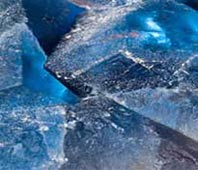
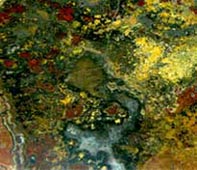
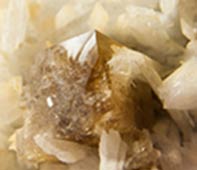
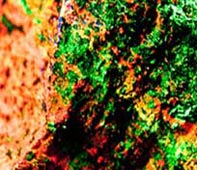
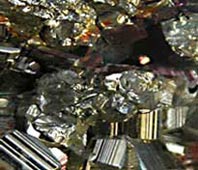
The Cambrian Radiation Revisited
by Kenjiro Hakomori
From: The Pick and Dop Stick, 1/2010
4th Place — 2011 MWF Original AduIt Articles
Fortey's book is a very good survey of life on the planet and how it has evolved over the course of the past few billion years with an emphasis on the last 540 million years from the Cambrian period when the fossil evidence becomes much more abundant. This emphasis is due to the preservation of more fossils in part, but also because the emergence of more complex life forms during this time. I will look at the theory of Cambrian radiation of animal life reflected in the sudden emergence of fossils which Fortey covers in his book with a side look at the greatest proponent of this theory, Stephen J. Gould. Sometimes referred to as the Cambrian explosion, the event marks a time when a great diversity of animal life emerged and when identifiably modern classes of animals emerged. It was from this radiation when the fossil record really emerges with consistency.
I have been fascinated with the Cambrian explosion especially after reading Stephen J. Gould's ground breaking work, A Wonderful Life (1990). This is where I will begin. Gould's book still remains a classic as a part biography of the great paleontologist Charles Doolittle Walcott, and his study of the Burgess Shale in Yoho National Park, and the detective work of Harry Whittington and his students in uncovering details about the fauna. This famous site continues to be one of the most prestigious fossil sites in the world because of the preservation of the fossil fauna located there. There in the shadow of Mount Stephen are fossils preserved like film on the black shale that show soft parts of the animal. Soft parts are extremely rare finds for fossils even from the recent past. Not only were soft parts of fossils preserved from animals that lived some 530 million years ago but a cornucopia of animals that had as yet been undiscovered were uncovered for the first time by Walcott at the turn of the twentieth century.
Gould's theory was that these animals were part of the explosion of life during the early Cambrian period. A number of these new animals discovered such as Hallucigenia and Anomalicaris were bizarre in appearance and seemed to differ greatly from today's animals. He then posited that during this explosion many different types of animals with different body plans emerged as kind of an experiment in diversity that would subsequently become winnowed through time by the historical process of evolution. Some of these forms died out while others survived.
In one dramatic example, Pikaia, an early animal with a notochord discovered there, he wrote that either this or its relations would one day become vertebrates, and ultimately us. But why did this insignificant animal at the time become the ultimate survivor who would go on to become the root of a hugely successful body plan and spawn the vertebrates? From here fishes, reptiles, and mammals evolved. His answer was that it was through the twists and turns of survival and even luck that brought this about. If another course of events unfolded it could have turned out quite different.
Fortey's reprise of this theory is that a number of these body plans though bizarre were within the confines of known classes. What Gould had posited as a bold new world was in fact something that had emerged from what was already known. In parallel with this development was the explosion of life forms having calcium phosphate shells. This is what accounts for the sudden and dramatic numbers of fossils found from these layers. And this would form the basis of the rise of all sorts of preserved shelly fossils from brachiopods to trilobites.
Since the Cambrian, the fossil record becomes more or less continuous because it was the first time that many animals with hard shells would leave fossils behind. Before the Cambrian much of the fossil record in comparison is "empty." This is due to preservation. Soft bodied animals leave very few traces, very few fossils behind unless certain very unique circumstances prevail, namely a sudden burial in anoxic conditions where very little bacteria can form to destroy the tissues, and where these traces of tissue get preserved through mineralization before they disappear. These circumstances occurred in areas such as the Burgess Shale and the more recently discovered site in Chenjiang, China. Ediacara, Australia is also a unique place where pre-Cambrian life forms without shells left their trace. Fortey writes that the rise of phosphates in the ocean had a dramatic impact because it was with this rise that marine animals developed shells of calcium phosphate that in turn provided sturdy defense in the constant battle between predator and prey.
The forms of modern animal life emerged in the Cambrian explosion, and were related to the modern classes that still exist. There were annelids, notochord-bearing pre-vertebrates, mollusks, trilobites, and all the strange animal life with odd body plans such as Hallucigenia were related to known animals, the Onychophorans (velvet worms). Even the bizarre Anomalicaris was an arthropod that went extinct during the Cambrian period.
So the sudden rise and dramatic radiation of different body plans was in fact within mainly one class—the arthropods. In fact, we could say that the Cambrian was the age of arthropods when they were the most dominant life form with many variations of body plans. Once these were called Trilobitomorpha in the early twentieth century. Now we know that this was a misnomer. They were in fact much more than Trilobitomorpha. They were unrelated or distantly related forms that differed significantly from trilobites, but they were still within the class Arthropoda.
What still stands true with Gould's theory that has been restated many different times by many different paleontologists since the theory of Evolution was first posited by Darwin is the periodic radiation of animals that occur from time to time. This pattern is seen whenever there are extinction events or large scale die-outs when life forms that were once dominant become scarce or extinct in a particular area, thus opening the way for other competitors to fill the niche. The Cambrian radiation still remains the classic case, but Fortey would say that the radiation of the animals followed the forms that had existed already, but what made it unique from all other radiations is that all animals that came after were identifiable offshoots of what can first be seen in the Cambrian.
Recent discoveries of Pre-Cambrian forms of life suggest that the last word has yet to be written, due to such discoveries like that of a Dickinsonia-like animal from the Ordovician in Morocco. Much of the theory of the Cambrian radiation is based on the complete turnover of animal life forms from the Pre-Cambrian. That many of the life forms of the Pre-Cambrian such as Spriginna, Dickinsonia and other soft bodied forms collectively known as Ediacaran fauna were unrelated to what followed in the Cambrian. This may yet prove to be an exaggeration if more of these soft-bodied animals are shown to have survived into the Cambrian and beyond.
For permission to reprint this article, contact us at info@chicagorocks.org.
